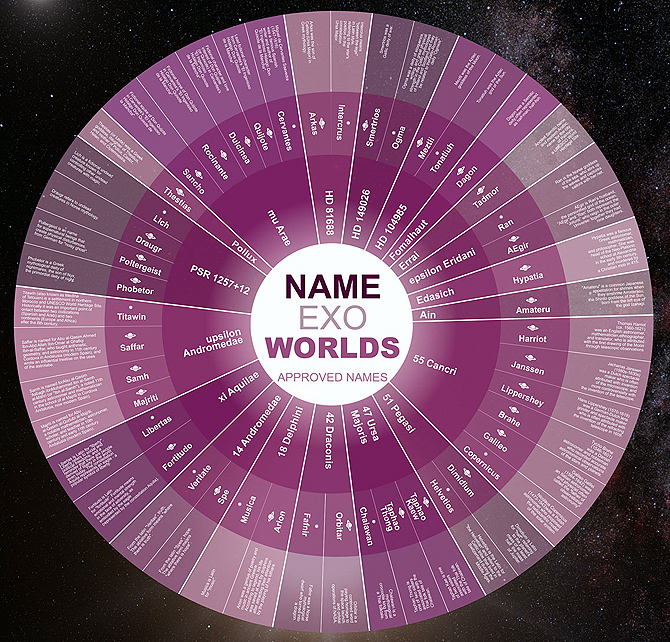Cervantes is already a star and its planets characters of Don Quixote. / Estrellacervantes.es
It was a difficult challenge, but with almost 70% of votes cast has been the clear winner Cervantes Spanish proposal to call the star μ (read ‘mu’) Arae, and baptize with the characters of Don Quixote their planets, now called Quixote, Rocinante, Sancho and Dulcinea.
The Cervantes’ proposal has been clearly won the competition, called NameExoWorlds, who had organized the International Astronomical Union ( IAU) this year to vote on proposals to rename 19 exomundos (formed by stars and planets) discovered in recent years. The Pamplona Planetarium and Astronomy Society presented Spanish Cervantes option.
The proposal ‘Star Cervantes’ competed with six others from different countries (Portugal, Italy, Colombia and Japan) to call the planetary system μ Arae, located 49.8 light-years away in the constellation Ara (the Altar). From 12 August to 31 October were open voting over the Internet, for everyone and limited only one vote per device (computer, phone or tablet).
More than 38,500 votes came from all over the world for the star μ Arae is called Cervantes, with its planets Quixote, Rocinante, Sancho and Dulcinea
The result, released Tuesday by the International Astronomical Union, leaves no doubt: the proposal has got 38,503 votes, 69% of the total cast for this star and its planets. From today therefore the names of Cervantes, Don Quixote, Rocinante, Sancho and Dulcinea can be used in parallel to the existing scientific nomenclature.
“This initiative is charged with meaning the work of those who work for scientific culture: a single proposal unites different aspects of science and literature, and has excited us both professionally we are dedicated to astronomy and all those who enjoy looking at the sky, “says Javier Armentia, director Pamplona Planetarium.
Meanwhile, Javier Gorgas, president of the Spanish Society of Astronomy, notes that “communicators and professional astronomy, media, scholars and lovers of literature have worked together with a single purpose: to make Cervantes and characters in their rightful place among the stars aligncenter size-full wp-image-34632 “src =”http://www.lagranepoca.com/wp-content/uploads/2015/12/logo-estrella-cervantes_large.jpg”
/www.lagranepoca.com/wp-content/uploads/2015/12/logo-estrella-cervantes_large.jpg "alt =" logo-star-cervantes_large "width =" 300 "height =" 300 "/>
“Don Quixote and his colleagues have helped us to proclaim that there are many more worlds in the universe adds, and along the way have claimed that science plays a central role in the culture and have found again the passion the general public in astronomy “.
Benjamin Montesinos, Spain contact point of the IAU for Disclosure of Astronomy, also expressed his joy at the result:” It was a pleasure and an honor for a manchego astronomer as being able to contribute to put his characters Cervantes and in heaven. When reread Don Quixote, we can imagine Clavileño flying and approaching the star and Dulcinea Cervantes, Don Quixote and Sancho Rocinante planets. A luxury. “
The campaign to solicit votes, dubbed #YoEstrellaCervantes has been present throughout the voting process in social networks and through estrellacervantes.es web. The driving entities, supported by the Cervantes Institute, thanked the participation of all voters; and especially schools, cultural organizations and associations of fans of astronomy who collaborated in disseminating the campaign and the media echo of the proposal were made.
Among the other new name adopted for other planetary systems include those from mythological figures from different cultures, as well as scientific or fictional characters, ancient cities or words of disappeared languages. In total, they have been baptized with new names to 14 stars and 31 planets from 19 distant exomundos.

New names of stars and planets in 19 plantarios systems. / IAU
Spain, third country participation
And the numbers speak for themselves: they could choose from a total of 274 names proposed by astronomical organizations from 45 countries and have received more than half a million votes (573,242 exactly), from 182 countries. Spain was the third country in percentage of participation, behind only India and the United States.
The proposal from the Complutense University of Madrid to call the planet Hypatia b iota Draconis has also triumphed
There is another Spanish winner: the planet around the star Iota Draconis, hitherto known as iota Draconis b, also called Hypatia on a proposal of the cultural association of the name of the Faculty of Physical Sciences at the Complutense University of Madrid.
Another proposal is accepted and promoted our country which adds to the star with the name of the author of Don Quixote. This comes when he is about to also begin Cervantes 2016, to commemorate the fourth centenary of the writer’s death.
In this context are preparing various outreach activities on the star Cervantes and detection exoplanets, which is expected to include several conferences and producing a planetarium film.
Original article here
No comments:
Post a Comment